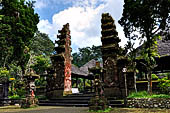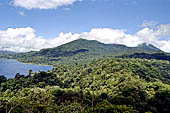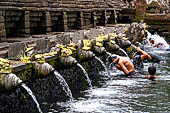|
|
| Hindu island in a muslim world. |
|
|
|
West Bali
The resort we choose is close to the black sands of Suraberata beach in the Tabanan region, at the end of a tiny village road winding through rice fields shaded by coconut. The villas are in small gardens surrounded by walls with terraces amidst the clouds and the crowns of palms. One of the best resorts in Bali in terms of surroundings and comfort.
Drive to Pura Luhur Batukaru between terraced rice fields and palm groves. Fields bustles with activities and there is always someone intent on bringing offerings to the temples dedicated to the spirits of agriculture. Pura Luhur Batukaru is immersed in the lush vegetation on the foothills of the third summit of the island, it is home to dozens of Meru. We continue the journey to the south direct to Mengwi to visit the Taman Ayun complex, the state temple of the Mengwi kingdom, and the sea temple of Tanah Lot perched on a rocky islet now a tourist cliché and thus losing most of its charm.
Pura Luhur Batukaru |

|
North Bali
Our resort was nestled in a small bay surrounded on three sides by mountains along the north coast in the Pemuteran area. The bungalows are in a beautifully kept garden with a wander-through feel and seem to have been constructed by Balinese woodwork craftsmen. Bungalows have an upper floor open on all sides. The open-air restaurant extends onto the beach under a magnificent banyan tree.
Forest and Bird Watching walk in West Bali National Park. We spent the entire morning trekking through the forest of Taman Nasional Bali Barat accompanied by a technical interpreter. The walk started along the muddy shore within the dense rainforest mangrove swamps, after we headed inland climbing the forested slopes of the low hills facing the Javanese coast in the tropical lowland forests. Near streamsides we easily spotted the small solitary Rufous-backed Kingfisher hunting from low perch over muddy waters. We ended our walk on the fields at Tegal Bunder where it is possible to visit the Bali Myna project release centre.

|
North Bali
|
We moved to Lovinia.
The hotel we stayed was situated among ricefield in a quiet and relaxing position. The black sands of Lovina beach did not inspire us, we did only an evening walk at low tide.
Drive to Singaraja to visit Northern Bali's temples. The temples of Northern Bali are notable for its statuary and carved panels and the characteristic flowery style of decoration very different from the other Balinese temples. First stop Pura Meduwe Karang with its remarkable sculptures and the famous relief of a cyclist. After we moved to Sangsit few kilometres East of Singaraja to visit Pura Beji characteristics for its pink sandstone and the nearby Pura Dalem with its erotic pictures and gruesome depictions of hell.
Drive to Pura Ulun Danu Bratan. The famous temple is located on the shores of Lake Bratan in the mountains at 1200 m above sea level and permanently shrouded in misty clouds. The heavy rain ruined the new moon ceremony in the morning. In the middle of the day a bright blue sky appeared though the dense white clouds. After the temple we went to the panoramic point to admire the mountain landscape of the Twin Lakes Lake Buyan, the larger one, and Lake Tamblingan.
North Bali |

|
Central and East Bali
Our stay in East Bali was split into two segments. First was Sanur, for its central location to take advantage of various day tours. Second was in the Amed area.
Sanur with its lovely only-pedestrian walkway stretching out over about 5km between the landscaped grounds of resorts on one side and the east-facing sandy coastline. 100 m. inland the busy Jl Danau Tamblingan with the hotel entrances, tourist shops, restaurants and cafes. Sanur is an excellent place to see the sunrise, “Bali is the morning of the world” appropriate sentence for the visitor of Sanur.
At the Northern end of the walkway there are the fast boats that take you to a day trip to Nusa Lembogan.
Drive to Besakih. The road to Besakih is very picturesque, passing the villages specialized in various craft productions. The "Mother Temple" is the most holy and Indonesia's biggest Hindu temple, built in an altitude of 1.000 m. on the slopes of Mount Agung. Considered the "navel of the world", Gunung Agung is the holiest mountain in Bali. After the temple visit, the drive continued towards the coast passing by the picturesque rice terraces along the way to the village of Sidemen with Gunung Agung on the background, ending to Klungkung to see the famous painted ceiling of the old "Palace of Justice".
Visit of the Bali Bird Park, the vast beautifully landscaped aviary north of Sanur, residence of the rare Bali starlings.

|
Pura Besakih
|
Drive to the rural area of Pejeng with extensive and ancient rice cultivations.
Temples visited: the old Pura Samuan Tiga 'the temple of the meeting of the three', the tantric Pura Kebo Edan with the big Bairava statue, Pura Penataran Sasih with the famous Moon of Pejeng, the largest single-cast bronze drum in the world, from the Bronze Age period. Pura Pusering Jagat with the bas-reliefs of the churning of the ocean of milk carved in a stone. Inside two large pavilions near the temple we had the chance to view a cock fighting party and very close a dance lesson to young children.
Drive to Goa Gajah Cave, with the famous giant demon head at the cave entrance. From here we tried to trek up to Yeh Pulu and we took a small track in the thick vegetation following a sign which was leading to a temple in the forest. After some time we understood that the path was leading to nowhere and we decided to reach by car this small archaeological site hidden among beautiful rice paddies.
Drive to Gunung Kawi and Tirta Empul. Gunung Kawi site with the two groups of rock-hewn tombs carved out on both sides of a river gorge. The Tirta Empul temple owes its existence to a holy water source from which derive the water for two bathing pools, one for the men and the other for women.
Tirta Empul |

|
Tirtagangga and Amed
We wanted to experience the quieter and less developed side of Bali, and the Amed area on the east coast was promising in this respect. Only few years ago the touristic development of this part of the island was still minimal and only recently tourism reached this eastern peninsula of Bali, the coastal road is now well paved and electricity had reached everywhere. Passed Amlapura, the main centre of the area a small city of on the south side of the peninsula, we stopped at Tirtagangga royal water garden situated along the road to Amed in the middle of rice fields. Continuing, the road passes spectacular sceneries, especially after Candidasa, with views of the Gunung Agung in the distance and of the rice paddies around Gunung Lempuyang. Amed is actually only the name of the first of a series of fishing villages along the coastal road. This area is comprised of many little traditional fishing villages nestled in beautiful bays along the coast. We settled in a very nice resort is at the very south end of the bay on a nice, although narrow, sandy beach, close to a fishing village. The black sand beach is always full with the pretty traditional jukung fishing outrigger canoes lined up on the sand. The water was clear but we were sceptical about snorkelling being possible. We ventured outside of the resort and walked the beach to experience the daily routines of the native residents. Fishing is the main subsistence activity. The fishermen go out in the early morning on self-made jukungs, although the local catch has become inadequate. Agriculture is very limited in the very dry hillsides without any irrigation.

|
Tirtagangga
|
| |
|
|
 |
|



